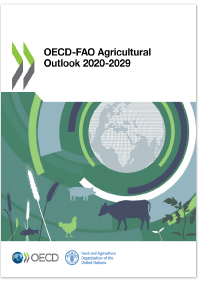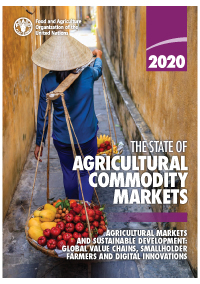Markets and Trade Publications
The State of Agricultural Commodity Markets 2020 (SOCO 2020)
Year of publication: 2020
Author: FAO
Publisher: FAO
Abstract:
The State of Agricultural Commodity Markets 2020 (SOCO 2020) aims to discuss policies and mechanisms that promote sustainable outcomes – economic, social and environmental – in agricultural and food markets, both global and domestic. The analysis is organized along the trends and challenges that lie at the heart of global discussions on trade and development. These include the evolution of trade and markets; the emergence of global value chains in food and agriculture; the extent to which smallholder farmers in developing countries participate in value chains and markets; and the transformative impacts of digital technology on markets. Along these themes, SOCO 2020 discusses policies and institutions that can promote inclusive economic growth and also harness markets to contribute towards the realization of the 2030 Agenda and its Sustainable Development Goals.
PRESS RELEASE | FAO webcast | Digital report | Online report | Printable version [pdf] | In Brief | VIDEO
Available in: English | Français | Русский | Español | العربية | 中文

COVID-19: Channels of transmission to food and agriculture
Year of publication: 2020
Author: FAO
Publisher: FAO
Abstract:
FAO is analysing and providing updates on the emerging COVID-19 pandemic’s effects on agricultural markets—effects that are still largely unknown. Most current assessments generally foresee a contraction in both supply of and demand for agricultural products, and point to possible disruptions in trade and logistics.
On the supply side, widely different views remain on the duration of the shocks, the price dynamics, differential impacts between domestic and international markets, differences across countries and commodities, the likely paths of recovery, and the policy actions to remedy the various shock waves.
On the demand side, there is near ubiquitous agreement that agricultural demand and trade would slow-down, with contractions stemming from a deceleration in overall economic activity (GDP growth) and rising rates of unemployment. While food and agricultural systems are exposed to both demand and supply side shocks (symmetric), these shocks are not expected to take place in parallel (asynchronous) since, inter alia, consumers can draw on savings, food stocks and safety nets.
Available in: English
Comparing crises: Great Lockdown versus Great Recession
Year of publication: 2020
Author: FAO
Publisher: FAO
Abstract:
A comparison of the Great Lockdown of 2020 underway with the Great Recession of 2009, reveals some regularities, yet many differences. Notably, the shock associated with the Great Recession arose out of economy-wide stress, particularly high-income countries, while in direct contrast, the Great Lockdown was borne outside of the global economic system, and seemingly is set to leave most countries severely affected, high and low-income countries alike. Both crises, however, have led to similar impacts to economies throughout the world, with significant contractions to economic growth, economic activity and employment.
For global food and agriculture, the Great Recession unfolded as a combination of two distinct crises that followed each other from 2007 to 2009. The initial 2007-2008 crisis was largely limited to food and agriculture, arising from a combination of supply and demand shocks within the global food sector. The 2009 crisis arose from an external demand side shock, brought about by the sharp contraction in overall economic activity in 2009, which is now known as the Great Recession. When referring to the Great Recession, this paper distinguishes two distinct sub-crises, i.e. the global food crisis of 2007-2008 and the global recession of 2009.
Available in: English
Food Outlook - Biannual Report on Global Food Markets
Year of publication: 2020
Author: FAO
Publisher: FAO
Abstract:
The Food Outlook is a biannual publication, focusing on developments affecting global food and feed markets. It provides comprehensive assessments and short term forecasts for production, utilization, trade, stocks and prices on a commodity-by-commodity basis, along with feature articles on topical issues. The Food Outlook maintains a close synergy with the Crop Prospects and Food Situation report published by the Global Information and Early Warning System (GIEWS) especially with regard to the coverage of cereals.
Available in: The full report is available in English, while market summaries are available in Arabic, Chinese, French, Russian and Spanish.

COVID-19 Policy Briefs Collection
Year of Publication: 2020
Author: FAO
Publisher: FAO
Abstract:
The COVID-19 pandemic is impacting not only food trade, food supply chains and markets but also people’s lives, livelihoods and nutrition.
This collection of policy briefs presents a qualitative and quantitative assessment of the pandemic’s impacts on these areas.
Available in: English | Français | Русский | Español | العربية | 中文
Crop Prospects and Food Situation
Year of Publication: 2020
Author: FAO
Publisher: FAO
Abstract:
Published quarterly, the report provides forward-looking analysis on regional food situations, focusing on cereal production, market and food security conditions and, in particular, Low-Income Food-Deficit Countries (LIFDCs). It indicates those countries requiring external food assistance and highlights the main drivers of food insecurity. The report also includes a global cereal supply and demand overview to complement the biannual analysis in the FAO Food Outlook publication.
Food Price Monitoring and Analysis (FPMA) Bulletin
Year of Publication: 2020
Author: FAO
Publisher: FAO
Abstract:
Published monthly, the bulletin illustrates the latest national, regional and global food price trends, with a focus on developing countries. It provides timely warnings on countries facing abnormally high prices, based on the GIEWS-developed Indicator of Food Price Anomalies (IFPA), a statistical measure of food price volatility and abnormal price growth.
Available in: English with selected abstracts in العربية, 中文, Français, Español and Русский

OECD-FAO Agricultural Outlook 2020-2029
Year of Publication: 2020
Author: FAO
Publisher: FAO
Abstract:
The OECD-FAO Agricultural Outlook 2020-2029 provides a consensus assessment of the ten-year prospects for agricultural and fish commodity markets at national, regional and global levels. The Agricultural Outlook report is a collaborative effort that connects commodity, policy and country experts from the OECD, FAO and beyond. It provides a medium-term assessment of demand, supply, trade and price trends for major agricultural commodities. This year's report includes an initial scenario analysis on the impact of the COVID-19 pandemic on the food and agriculture system.
PRESS RELEASE | FAO webcast | Projections by commodity are available in English and French.

OECD-FAO Agricultural Outlook 2020-2029 Executive Summary
Year of Publication: 2020
Author: FAO
Publisher: FAO
Abstract:
The Agricultural Outlook 2020-2029 is a collaborative effort of the Organisation for Economic Co-operation and Development (OECD) and the Food and Agriculture Organization (FAO) of the United Nations. It brings together the commodity, policy and country expertise of both organisations as well as input from collaborating member countries to provide an annual assessment of the prospects for the coming decade of national, regional and global agricultural commodity markets. This year's edition features a short scenario on COVID-19 and its impact on food and agriculture.
Available in: English | Français | Русский | Español | العربية | 中文

Trade and Sustainable Development Goal 2 – Policy options and their trade-offs
Year of publication: 2020
Author: FAO
Publisher: FAO
Abstract:
With trade recognized as a means of implementation under Agenda 2030, policy-makers will need to ensure that trade, and policies affecting trade and markets, are taken into consideration as part of their efforts to achieve SDG 2. The five targets that set out the level and ambition of SDG 2 (ending hunger; ending all forms of malnutrition; doubling the agricultural productivity and incomes of small-scale food producers; ensuring sustainable food production systems; and maintaining genetic diversity), as well as trade itself, often constitute distinct policy priorities for governments. Trade and related policy measures that may be designed to achieve one target can potentially have unintended negative consequences that undermine the achievement of other targets, both within the country where the measure is applied and in the trading partner countries. It is therefore important that policy-makers identify and recognize areas in which difficult tradeoffs may be needed between competing policy objectives, and identify possible ways in which these can be addressed. Furthermore, while the different targets set out under SDG 2 are mutually interdependent and inter-related, it is important to address the trade policy dimension of each component individually as part of a broader plan of action.
Available in: English

Trade and Sustainable Development Goal 2 – Policy options and their trade-offs Executive Summary
Year of publication: 2020
Author: FAO
Publisher: FAO
Abstract:
With trade recognized as a means of implementation under Agenda 2030, policy-makers will need to ensure that trade, and policies affecting trade and markets, are taken into consideration as part of their efforts to achieve SDG 2. The five targets that set out the level and ambition of SDG 2, as well as trade itself, often constitute distinct competing policy priorities for governments. It is therefore important that policy-makers identify and recognize areas in which difficult tradeoffs may be needed between competing policy objectives, and identify possible ways in which these can be addressed. Furthermore, while the different targets set out under SDG 2 are mutually interdependent and inter-related, it is important to address the trade policy dimension of each component individually as part of a broader plan of action.

OILCROPS COMPLEX
Policy Changes and Industry Measures Annual compendium
Year of publication: 2020
Author: FAO
Publisher: FAO
Abstract:
The annual compendium provides a concise overview of policy developments and related private sector measures relevant to the oilcrops industry at the global, regional and national level.
An introductory section offers a brief discussion of the key policy trends observed during the year 2019, while the core of the report consists of a tabular presentation of detailed news items, grouped by policy domains.
The compendium assists policy makers, market experts and key stakeholders in monitoring and analyzing the impact of specific commodity policies on trade, food security and national agri-food systems. The report supports national efforts to make informed, evidence-based policy decisions and allows countries to take advantage of global, regional and domestic trade and market opportunities.
Available in: English
See also: Past editions | Monthly updates

Report of the 23rd Session of the IGG on Tea
Year of publication: 2020
Author: FAO
Publisher: FAO
Abstract:
The FAO Intergovernmental Group (IGG) on Tea represents a forum for intergovernmental consultation and exchange on trends in production, consumption, trade and prices of tea, including regular appraisal of the global market situation and short term outlook. The Group, under FAO auspices, considers changes in national policies and examines their international effects as pertaining to the current and prospective market situation.
Available: English

Report of the Joint Meeting of the 40th Session of the IGG on Hard Fibres and the 42nd Session of the IGG on Jute, Kenaf, and Allied Fibres
Year of Publication: 2020
Author: FAO
Publisher: FAO
Abstract:
The FAO Intergovernmental Group (IGG) on Jute, Kenaf and Allied Fibres represents a forum for intergovernmental consultation and exchange on trends in production, consumption, trade and prices of jute, kenaf and allied fibres, including regular appraisal of the global market situation and short term outlook. The Group, under FAO auspices, considers changes in national policies and examines their international effects as pertaining to the current and prospective market situation.
Available in: English

Trade Policy Briefs
Year of publication: 2020
Author: FAO
Publisher: FAO
Abstract:
Trade Policy Briefs provide a succinct overview of key trade policy questions addressed in recent FAO studies with the view to broaden the understanding on such issues, especially in the context of the WTO negotiations on agriculture.






